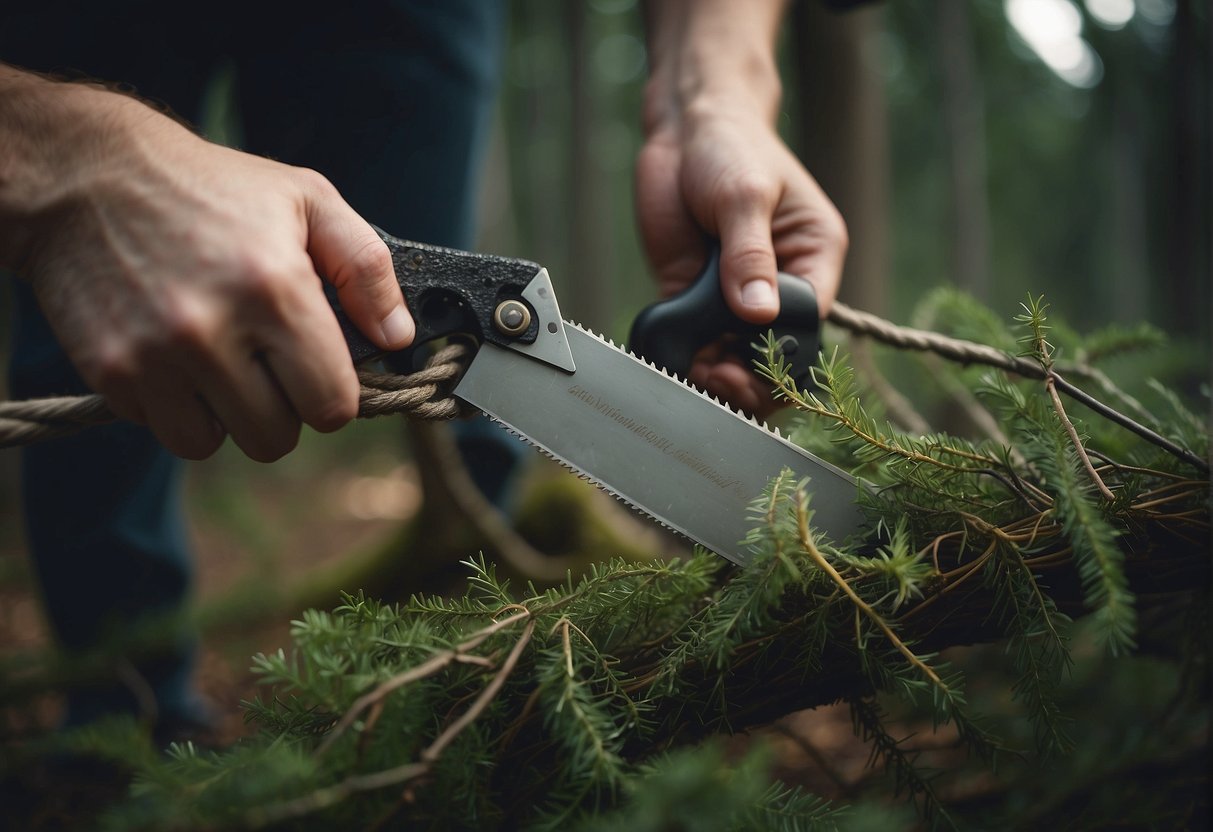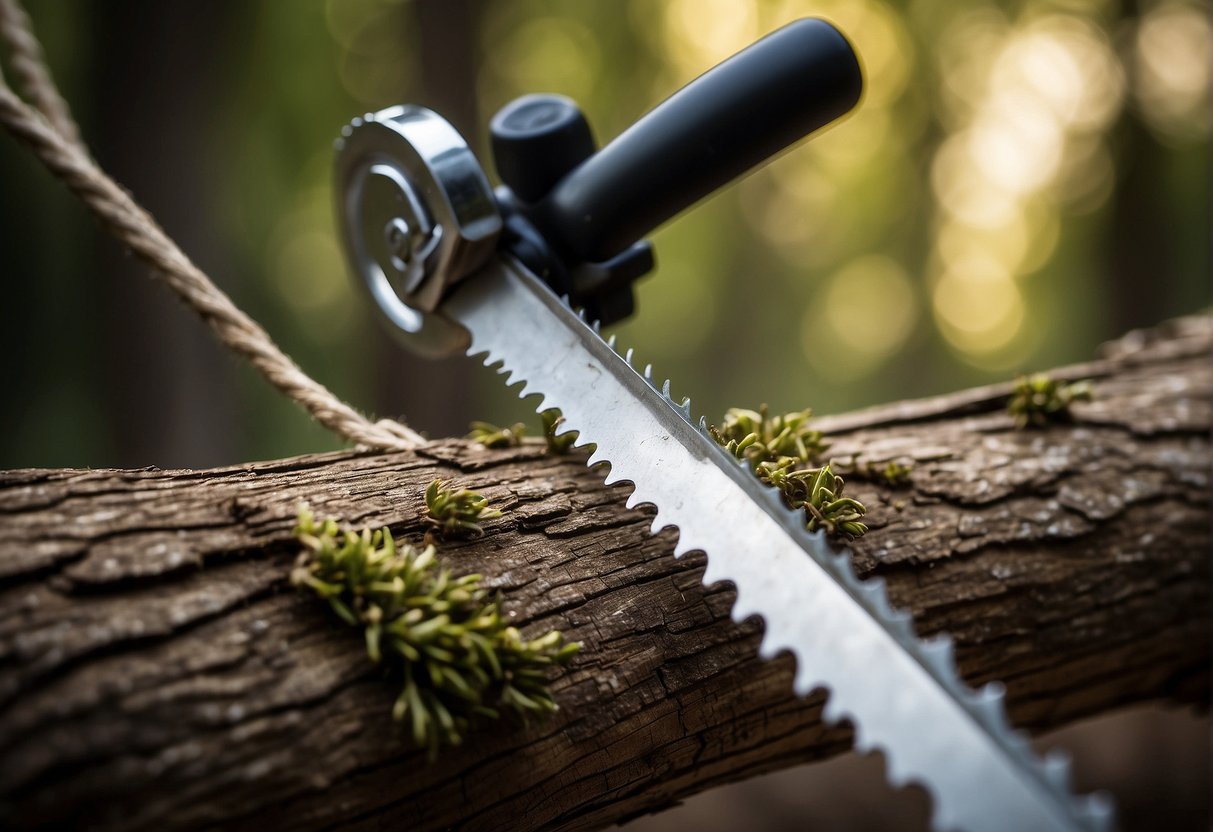I have been using rope saws for years now, and one of the most frustrating things that can happen is when the saw gets stuck in a branch. Not only can it be difficult to remove, but it can also be dangerous. That’s why it’s essential to know how to keep your rope saw from getting stuck in the first place.
Choosing the right rope saw is the first step in avoiding getting stuck. Make sure to select a saw that is appropriate for the job you are doing and the type of wood you are cutting. If you are cutting thicker branches, you may need a saw with longer teeth, while a shorter blade may be better for smaller branches. Additionally, make sure to inspect the saw before each use to ensure it is in good condition.
Preparation before cutting is also crucial. Before you start cutting, make sure the rope is properly secured and that there is enough slack in the rope to allow for movement. You should also make sure that the branch is stable and not likely to move or sway during cutting. Taking these steps can help prevent the saw from getting stuck and keep you safe while cutting.
Key Takeaways
- Choosing the right rope saw is crucial for avoiding getting stuck.
- Proper preparation before cutting can help prevent the saw from getting stuck.
- Effective cutting techniques and troubleshooting common issues can help you avoid getting stuck.
Choosing the Right Rope Saw
When it comes to choosing the right rope saw, there are a few things to consider. In this section, I will go over the different types of rope saws, blade selection, and rope quality and length.
Type of Rope Saw
There are two main types of rope saws: wire saws and chain saws. Wire saws consist of a flexible wire with teeth along one side that cuts when pulled back and forth. Chain saws, on the other hand, have a circular blade that rotates around a guide bar.
Wire saws are lightweight and compact, making them a great option for backpacking and camping trips. They are also less expensive than chain saws. However, wire saws are not as durable as chain saws and are better suited for cutting smaller branches and limbs.
Chain saws are more powerful and durable than wire saws, making them a better choice for heavier-duty cutting tasks. They are also more expensive and heavier than wire saws. Chain saws come in various types, including professional rope saws, pole saws, and high limb chainsaws.
Blade Selection
The type of blade you choose will depend on the type of cutting you plan to do. Blades come in different lengths and tooth configurations. Longer blades are better for cutting thicker branches, while shorter blades are better for smaller branches.
Blades with larger teeth are better for cutting through thicker branches, while blades with smaller teeth are better for cutting through smaller branches. It’s also important to choose a blade that is made from high-quality materials, as this will ensure that it stays sharp for longer.
Rope Quality and Length
The quality and length of the rope you use with your saw is also important. Look for rope that is strong and durable, as this will ensure that it doesn’t break or fray during use. The length of the rope will depend on the height of the branches you plan to cut.
It’s important to choose a rope that is long enough to reach the branches you want to cut, but not so long that it becomes difficult to control. A good rule of thumb is to choose a rope that is at least twice the length of the branches you plan to cut.
In conclusion, when choosing the right rope saw, consider the type of saw, blade selection, and rope quality and length. By taking the time to choose the right saw for your needs, you can ensure that your saw stays sharp and doesn’t get stuck during use.
Preparation Before Cutting
Before starting to cut with a rope saw, it is important to take some necessary precautions and prepare for the task. Here are some tips to ensure a safe and effective cutting process:
Safety Gear
First and foremost, it is important to wear appropriate personal protective equipment (PPE) to prevent any injuries while using the rope saw. This includes safety glasses, gloves, and a hard hat to protect your eyes, hands, and head respectively. Additionally, it is important to wear sturdy shoes with good traction to prevent slipping.
Inspecting Equipment
Inspecting the rope saw before each use is crucial to ensure that it is in good working condition. Check for any frayed areas or tears in the rope and replace it immediately if any damage is found. Inspect the handle and make sure it is securely attached to the rope. Also, check the blade to ensure it is sharp and not damaged. A dull blade can cause the saw to bind in the cut.
Setting Up the Rope Saw
Proper setup of the rope saw is essential to prevent it from getting stuck while cutting. Before using the rope saw, make sure it is properly lubricated to ensure smooth movement of the blade. Ensure that the rope is properly secured to the branch or limb to prevent it from slipping during the cut. It is also important to ensure that the rope saw is positioned correctly to avoid any awkward angles that may cause the saw to bind in the cut.
By following these preparation steps, you can ensure a safe and effective cutting process with your rope saw. Always prioritize safety and take the time to properly inspect and set up your equipment before starting any cutting task.
Effective Cutting Techniques
As I have mentioned before, using a rope saw can be tricky, and it is important to use proper techniques to avoid getting it stuck. In this section, I will discuss some effective cutting techniques that will help you use a rope saw efficiently.
Proper Tension and Handling
One of the most important things to keep in mind when using a rope saw is to maintain proper tension. If the rope is too loose, it can get stuck in the cut, and if it is too tight, it can break. Therefore, you need to make sure that you are holding the rope with the right amount of tension. You can also use a tool like a rope grab to maintain tension.
Another important aspect of proper handling is to make sure that you are using the saw correctly. Make sure that you are pulling the saw in the right direction and at the right angle. This will help you avoid getting the saw stuck.
Direction and Force
When cutting with a rope saw, it is important to use the right direction and force. You should always cut in a downward direction, as this will help the saw move through the wood more easily. Additionally, you should use a steady and even force when cutting. If you use too much force, the saw can get stuck, and if you use too little force, the saw may not cut through the wood.
Working with Gravity
Working with gravity can also help you avoid getting your rope saw stuck. When using a rope saw, try to position yourself in a way that allows gravity to help you. For example, if you are cutting a branch that is hanging down, try to position yourself below the branch so that gravity is pulling the saw down. This will help you cut through the branch more easily.
Conclusion
By using these effective cutting techniques, you can avoid getting your rope saw stuck. Remember to maintain proper tension, use the right direction and force, and work with gravity. Additionally, it can be helpful to have two people working together, with one person holding the rope and the other person cutting. With practice and patience, you can become an expert at using a rope saw.
Troubleshooting Common Issues
Dealing with a Stuck Saw
When using a rope saw, it is not uncommon for it to get stuck. If this happens, do not try to force the saw through the material. Instead, gently wiggle it back and forth until it comes free. If the saw continues to get stuck, it may be due to a dull or damaged blade. In this case, you should sharpen or replace the blade.
Maintenance and Repairs
To prevent your rope saw from getting stuck, regular maintenance is essential. Before each use, inspect the saw’s rope, handle, and blade for any signs of damage or wear. If any parts are frayed or damaged, replace them immediately. Also, clean the saw’s blade after each use to prevent debris from building up and causing the saw to get stuck.
If your rope saw is not starting, it may be due to a damaged part or a clogged air filter. In this case, you will need to open up the saw and inspect the parts. If you are not comfortable doing this, take the saw to a professional for repair.
Replacing Worn Parts
Over time, parts of your rope saw may become worn and need to be replaced. This includes the starter rope, starter assembly, and gaskets. When replacing these parts, be sure to follow the manufacturer’s instructions carefully. Also, make sure to use the proper tools and screws to avoid damaging the saw.
In addition to replacing worn parts, it is important to keep your saw’s blade sharp. A dull blade can cause the saw to get stuck and make cutting more difficult. To sharpen the blade, use a sharpening stone or file and follow the manufacturer’s instructions.
By following these tips, you can prevent your rope saw from getting stuck and ensure that it continues to work properly.
Advanced Tips and Techniques
Working with Knots and Tangles
Sometimes, despite our best efforts, the rope saw can get tangled or caught up in knots. If this happens, don’t panic. Instead, take a deep breath and try to work through the problem. One technique that I’ve found helpful is to use a hammer and wedges to create a small gap in the cut. This can help to release the tension on the saw and allow you to work out the knot or tangle.
Another trick is to use a ladder to get a better angle on the cut. This can help you to see where the problem is and give you more leverage to work through it. If you’re working with a particularly stubborn knot, you may need to use a combination of techniques to get it unstuck.
Felling and Limbing Strategies
When it comes to felling and limbing trees, experience is key. However, there are a few strategies that can help you to work more efficiently and safely. One technique that I’ve found helpful is to work in sections. Instead of trying to take down the entire tree at once, focus on one section at a time. This can help to reduce the risk of accidents and make the job more manageable.
Another important strategy is to use the right tools for the job. Make sure that you have a sturdy ladder and a sharp saw. You may also want to invest in a good pair of safety glasses and a hard hat to protect yourself from flying debris.
Collaborative Sawing
If you’re working on a particularly large tree, you may want to consider collaborating with another person. This can help to reduce the amount of time and effort required to complete the job. One person can work on the top of the tree while the other works on the bottom. Alternatively, you can work on opposite sides of the tree and meet in the middle.
When working collaboratively, it’s important to communicate clearly and work together as a team. Make sure that you establish a plan before you begin and that you’re both comfortable with the techniques being used. With the right approach, collaborative sawing can be a safe and efficient way to take down even the largest trees.
Frequently Asked Questions
What techniques can prevent a rope saw from binding in a tree?
To prevent a rope saw from binding in a tree, it is important to ensure that the area you are cutting is clear of debris. Do not try to force the saw through the material, let the blade do the work. It is also important to make gentle starts on the rope saw, and to keep the chain inline with the angle of the cut.
What are the best practices for using a high limb rope saw on tree branches?
When using a high limb rope saw on tree branches, it is best to make sure that the saw is over the correct branch. The weight that keeps the teeth in contact with the branch doesn’t always work, so it is important to make tiny back-and-forth motions to cut through whatever is causing the saw to hang. It is also critical to keep the chain inline with the angle of the cut.
Can you provide tips for maintaining a rope saw to avoid it getting stuck?
To avoid a rope saw getting stuck, it is important to check the saw before each use to make sure that it is not damaged or frayed. Keep the rope saw clean and lubricated according to the manufacturer’s instructions. Replace the blade if it’s damaged or overly dull.
What should be done if a rope saw gets stuck during use?
If a rope saw gets stuck during use, gently wiggle it back and forth until it comes free. Do not try to force the saw through the material, as this could cause the saw to break or become damaged.
How does one choose the right rope saw for cutting tree limbs?
When choosing a rope saw for cutting tree limbs, it is important to consider the size of the tree limbs you will be cutting. Choose a saw with a blade that is long enough to cut through the thickest limbs you will be working with. It is also important to choose a saw with a comfortable grip that you can hold onto for extended periods of time.
What are the safety precautions to take when operating a hand chain saw?
When operating a hand chain saw, it is important to wear protective gear, including eye protection, ear protection, and gloves. Always make sure that the saw is in good working condition before use, and never use a saw with a damaged or frayed blade. Always follow the manufacturer’s instructions for use and maintenance.

Hi, I’m Sal Muller of Tooltrip.com. My DIY experience led me to understand essential power tools for home projects. Tooltrip.com guides enthusiasts and professionals in choosing right tools for any job. I provide concise top tool reviews for easier, efficient DIY.





